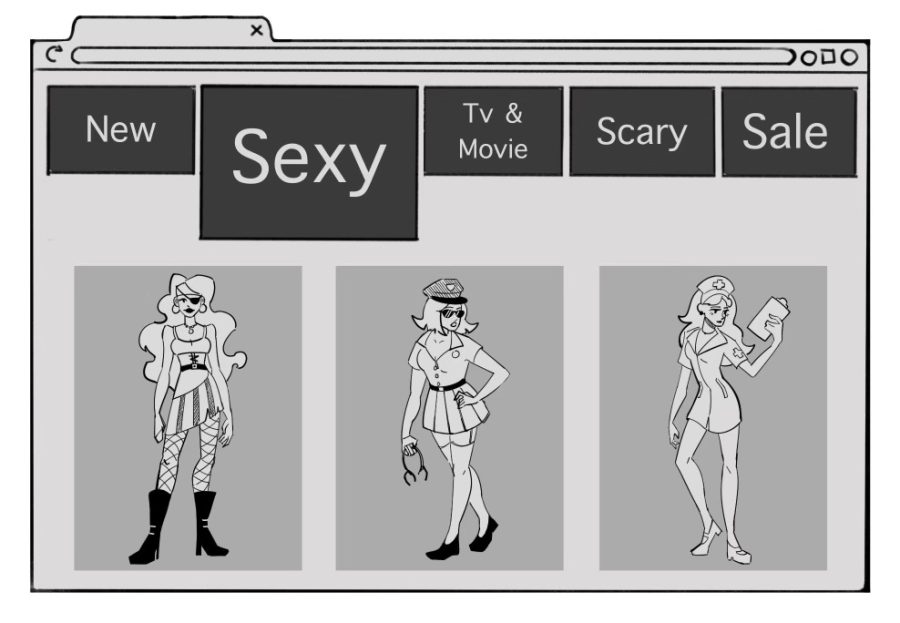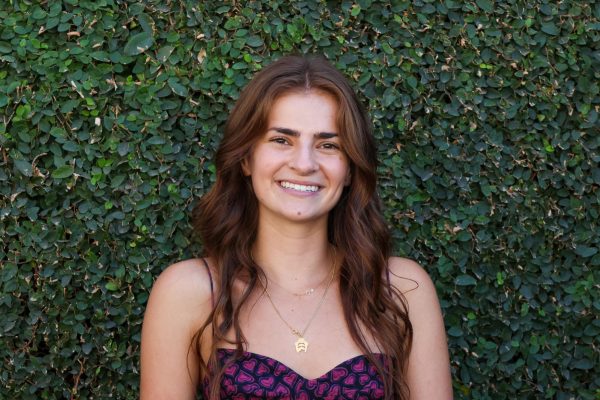From Candy Bars to Eye Candy
Illustration by Chiara Umekubo
While scrolling for Halloween costumes, the category of “Sexy” can seem like the only one for girls.
November 7, 2022
“In girl world, Halloween is the one night a year when a girl can dress up like a total sl*t and no other girls can say anything about it,” Regina George explained, twirling in her playboy bunny halloween costume. The line is an iconic one from cult movie classic Mean Girls, but represents a more deeply rooted societal issue which has manifested itself in a popular American holiday: the sexualization of women’s Halloween costumes.
Looking for a Halloween costume during childhood was a ritual. It was like brushing my teeth before leaving the house in the sense of its habit. Narrowing down the field to ladybug or taco and maybe clicking the light up option which mom would eventually deselect because why would she ever want to spend forty dollars on something worn once and then stuffed in the back drawer? When the Party City package arrived, it was immediately ripped open and rushed upstairs for a try on. Zippers zipped, belts buckled, the mirror was a window to another world where fabric gave flight and plastic wands whispered magical incantations.
When the children’s section no longer fit and trick or treating itself seemed to cling a little too tightly in the sleeve area, it was time to click on the first tab of the Halloween website: Women’s costumes. In the website’s filter section, light up was no longer the first choice. Staring at the first option which seemed like the only was… “Sexy.” Suddenly, when the costume arrived from Party City and zippers were zipped and belts were buckled, the mirror was a magnifying glass and the only thing in view was skin and figure, or lack thereof.
Scrolling through costumes worn by women with developed figures at a young age can be a fear causing practice. Looking at a certain type of body that is branded as sexy can cause insecurity in girls going through puberty or who haven’t experienced the same changes yet, and turns what once was a joy inducing experience into something stressful.
Sexualization occurs when a person’s value comes only from someone’s sexual appeal or behavior, to the exclusion of other characteristics, and when a person is sexually objectified, according the American Psychological Association (APA). In a study conducted by the APA task force, research concluded that sexualization of girls negatively affects girls and young women across a variety of domains, one being cognitive and emotional consequences, as sexualization and objectification undermined a person’s confidence in and comfort with her own body, leading to emotional and self-image problems, such as shame and anxiety. What some may not consider in terms of costume decisions is that being the odd one out in terms of costume choice can feel more isolating than being objectified.
In our generation, girls are expected to dress in a sexy costume. Deciding to just not wear one, which may seem like the obvious solution, can lead to deeper concerns about attention and public perception. Going to a party with the friend group, knowing that all the other girls are wearing sexy angel costumes and one person is wearing a dragon onesie, chances are dragon onesie girl is going to spend the whole car trip wishing she had slipped on a lace cami and wings so that maybe she would get attention from the guy she likes that’s going.
A double edged sword welds itself when girls have to choose between being uncomfortable in their own skin wearing costumes they feel required to wear or unable to gain attention if they chose to wear a more modest costume. Buying a costume, like the habit of brushing teeth, becomes something entirely different, as the experience is no longer ritual but masked in worry of how fresh will my breath be when I get to school or are my teeth white enough?
The dilemma has led girls into dark places of decision, but Halloween can also be looked at as a day of freedom for girls.
People assume that women’s costumes have to be looked at negatively, but it can actually be a form of self expression. The media has forced an idealized body type and style of clothing onto women, but there is room to reclaim certain costumes as a form of expression and confidence building. When Regina George explains her Halloween theory, she views the night through a lens of femininity, as Halloween is a day of freedom for women.
If you want to wear a certain outfit and if you feel comfortable and feel like it’s a good costume for you, then go for it. Costumes can be looked at it from a more positive perspective in that it’s not just about impressing but that there are other factors. To say that all women are made uncomfortable by the sexier aspects of Halloween costumes would be an unfair statement, as women all have equally important views on Halloween costumes even if they are separate. Some women look forward to having an opportunity to dress in less clothes on a certain day and other people see it as just another day. Seeing sexier costumes online can spark creativity to be different from what everyone else is doing. Everyone is a SWAT officer, anyway.
Halloween is society’s ordained one night of the year where girls can supposedly dress how they want without fear of being judged or shamed by other people for their outfits, but the media has molded it into a night of fear for many, and not just of ghosts and vampires. Choosing a costume is an entirely personal decision, and if a girl expresses herself with a costume that enhances her sexuality and femininity, that choice is equally ok with being Darth Vader for Halloween. The magic of Halloween deserves to live on past elementary school, so take a chance not on what others expect, but what will make the mirror a window, not a magnifying glass.
































